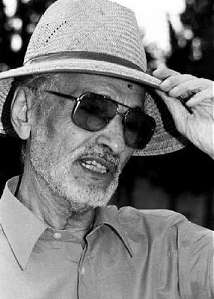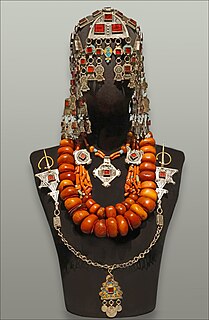Related Research Articles

Algeria, officially the People's Democratic Republic of Algeria, is a country in North Africa. Algeria is bordered to the northeast by Tunisia; to the east by Libya; to the southeast by Niger; to the southwest by Mali, Mauritania, and Western Sahara; to the west by Morocco; and to the north by the Mediterranean Sea. It is considered to be a part of the Maghreb region of North Africa. It has a semi-arid geography, with most of the population living in the fertile north and the Sahara dominating the geography of the south. Algeria covers an area of 2,381,741 square kilometres (919,595 sq mi), making it the world's tenth largest nation by area, and the largest nation in Africa. With a population of 44 million, Algeria is the ninth-most populous country in Africa, and the 32nd-most populous country in the world. The capital and largest city is Algiers, located in the far north on the Mediterranean coast.

The Berber languages, also known as the Amazigh languages, are a branch of the Afroasiatic language family. They comprise a group of closely related languages spoken by the Berbers, who are indigenous to North Africa. The languages were traditionally written with the ancient Libyco-Berber script, which now exists in the form of Tifinagh.

North Africa or Northern Africa is a region encompassing the northern portion of the African continent. There is no singularly accepted scope for the region, and it is sometimes defined as stretching from the Atlantic shores of Mauritania in the west, to Egypt's Suez Canal.

Berbers or Imazighen are an ethnic group indigenous to North Africa, specifically Morocco, Algeria, Tunisia, and Libya, and to a lesser extent Mauritania, northern Mali, and northern Niger. Smaller Berber populations are also found in Burkina Faso and Egypt's Siwa Oasis. Historically, Berber, or Amazigh, nations have spoken Berber languages, which are a branch of the Afroasiatic language family.

The Maghreb, also known as Northwest Africa, is the western part of North Africa and the Arab world. The region includes Algeria, Libya, Mauritania, Morocco, and Tunisia. The Maghreb also includes the disputed territories of Western Sahara and the Spanish cities Ceuta and Melilla. As of 2018, the region had a population of over 100 million people.

Berberism or Amazighism is a Berber political-cultural movement of ethnic, geographic, or cultural nationalism, started mainly in Kabylia (Algeria) and in Morocco, later spreading to the rest of the Berber communities in the Maghreb region of North Africa. A Berber group, the Tuaregs, have been in rebellion against Mali since 2012, and established a temporarily de facto independent state called Azawad, which identified itself as Berber.
Arabized Berber denotes an inhabitant of the Maghreb region in western North Africa, whose native language is a local dialect of Arabic and whose ethnic origins are Berber.

Moroccans are the citizens and nationals of the Kingdom of Morocco. The country's population is predominantly composed of Arabs, Arabized Berbers, and Berbers. The term also applies more broadly to any people who are of Moroccan descent, sharing a common culture and identity, as well as those who natively speak Moroccan Arabic or other Moroccan languages.

The Royal Institute of Amazigh Culture is an academic institute of the Moroccan government in charge with the development and the promotion of the Berber languages and culture and of the development of Berber language courses for Morocco's public schools.

Mohamed Chafik, born 17 September 1926, is a leading figure in the Amazigh cultural movement. An original author of the Amazigh Manifesto, he was later appointed as the first Rector of the Royal Institute of the Amazigh Culture. He has worked extensively on incorporating Amazigh culture into Moroccan identity and is a leading intellectual of the Moroccan intelligentsia.
Helene E. Hagan, born Helene Coll, is an American anthropologist and Amazigh activist.

Central Atlas Tamazight or Atlasic is a Berber language of the Afroasiatic language family spoken by 2.3 million in the Atlas Mountains of Central Morocco as well as by smaller emigrant communities in France and elsewhere.

Tamazight of Djerba, Chelha of Djerba, or Djerbi is a Berber language of the Eastern Maghreb, spoken on the island of Djerba, in Tunisia. It is a component of what is regularly denominated Tunisian “Chelha”, in the south of the country.

The Berber flag is a flag that has been adopted by many Berber populations including protestors, cultural and political activists. It is currently used by Berber political and cultural activists and organizations in 10 African countries, namely: Morocco, Algeria, Tunisia, Libya, Mauritania, Mali, Niger, Burkina Faso, Egypt and the Canary Islands.
Arab-Berbers are an ethnolinguistic group of the Maghreb, a vast region of North Africa in the western part of the Arab world along the Mediterranean Sea and the Atlantic Ocean. Arab-Berbers are people of mixed Arab and Berber origin, most of whom speak a variant of Maghrebi Arabic as their native language, some also speak various Berber languages. Many Arab-Berbers identify primarily as Arab and secondarily as Berber.

The World Amazigh Congress (CMA) is an international non-governmental organization made up of Amazigh sociocultural and development associations from both North Africa and the diaspora to have a coordination and representation structure.
North African Americans are Americans with origins in the region of North Africa. This group includes Americans of Algeria, Egypt, Libya, Morocco, and Tunisia.
Berber Americans, American Berbers or Amazigh Americans, are Americans of Berber descent. Although a part of the population of the Maghreb is of Berber descent, only 1,327 people declared Berber ancestry in the 2000 US Census. People of Berber origin in United States have created several associations with goal of maintaining and strengthening their language and culture, such as the Amazigh Cultural Association in America (ACAA), The United Amazigh Algerian (UAAA), The Amazigh American Association of Washington, DC., and the Boston Amazigh Community.

Moha Ennaji ; is a Moroccan linguist, author, political critic, and civil society activist. He is a university professor in the Department of English Language and Literature at Sidi Mohamed Ben Abdellah University at Fes, where he has worked for over 30 years. In addition to his publications in linguistics, he has written on language, education, migration, politics, and gender, and is the author or editor of over 20 books.

Jewelleryof the Berber cultures is a historical style of traditional jewellery that was worn by women mainly in rural areas of the Maghreb region in North Africa and inhabited by indigenous Berber people. Following long social and cultural traditions, Berber or other silversmiths in Morocco, Algeria and neighbouring countries created intricate jewellery with distinct regional variations. In many towns and cities, there were Jewish silversmiths, who produced both jewellery in specific Berber styles as well as in other styles, adapting to changing techniques and artistic innovations.
References
- 1 2 Olivia Miller (November 26, 2008). "A Countries and Their Cultures: Algerian Americans". Countries and their cultures. Retrieved May 22, 2010.
- 1 2 "The World News II: Amazigh Cultural Association in America". Archived from the original on 2013-12-20. Retrieved 2013-12-20.